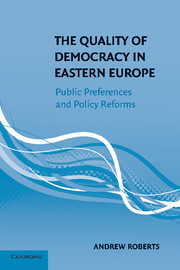2 - Assessing the Quality of Democracy
Published online by Cambridge University Press: 06 July 2010
Summary
For more than two decades, from the Carnation Revolution in Portugal to the Velvet Revolutions in Eastern Europe and beyond, the field of comparative politics has been preoccupied with the question of democratic transitions. The main issues are now well known: What factors lead a country to become democratic? Are transitions a product of social and economic changes or are they influenced by fortuitous events and strategic choices? And what, if anything, can the established democracies do to promote democracy around the world? So powerful was the paradigm that it even received its own name: transitology.
Although this research program has had its critics, its successes should not be overlooked. Studies of democratization have yielded a large number of powerful and subtle results derived from both large-N quantitative analyses and detailed case studies of individual transitions and nontransitions (Geddes 1999). Indeed, it would be hard to name a research program in comparative politics that has been as successful as the one looking into the causes of democracy and, more recently, the reasons for its persistence.
This chapter considers an unspoken assumption that underlies this paradigm. The assumption is that a transition to democracy inevitably leads to better political and social outcomes. Promoting democracy means promoting better public policies, less corruption, and, central to the argument of this book, more responsive and accountable rulers.
The assumption is not ungrounded. Free and fair elections give leaders a powerful incentive to produce better policy.
- Type
- Chapter
- Information
- The Quality of Democracy in Eastern EuropePublic Preferences and Policy Reforms, pp. 21 - 48Publisher: Cambridge University PressPrint publication year: 2009



